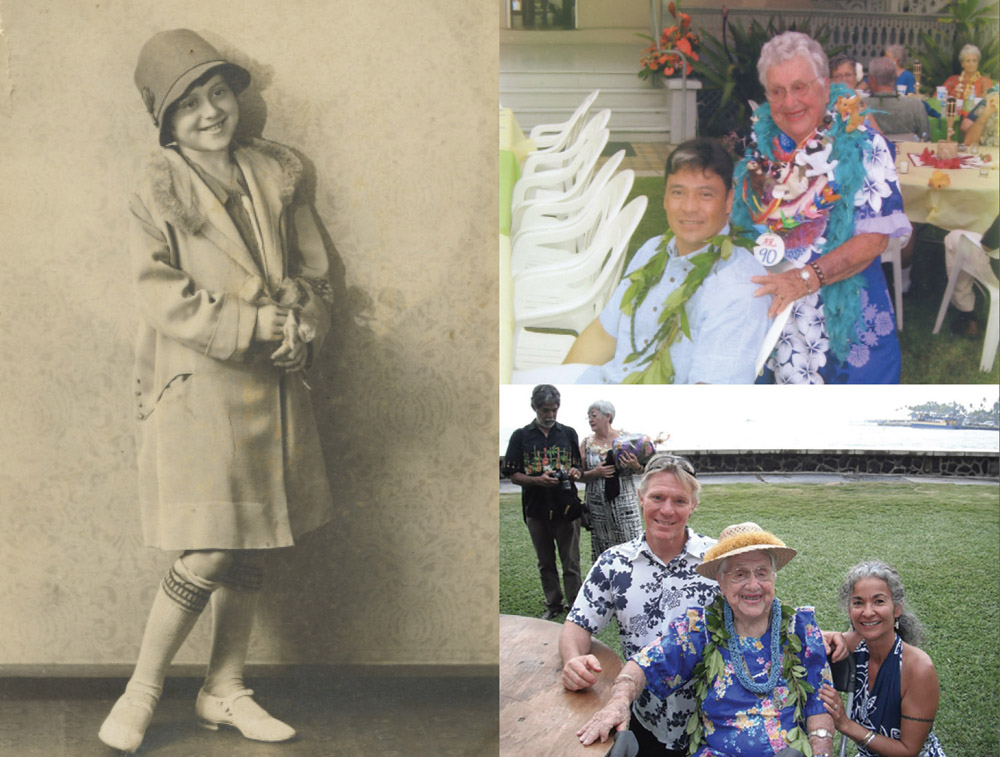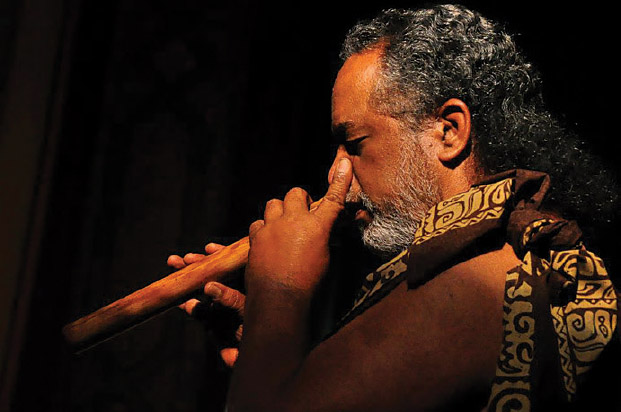
Kona’s “Grama Lee”
 By Kate Kealani H. Winter
By Kate Kealani H. Winter
The first thing you might notice about Grama Lee is the fire in her eyes. It matches the colorful language that she uses freely in conversation. Grama Lee, now 97 years old, was born Irene Pearl Potbury and named after St. Irenaeus, whose feast day is the day before her birthday, and Pearl White, the adventurous actress of the Perils of Pauline movies. She combines some of both namesakes into a charming, tell-it-like-it-is character well loved in Kona.
She grew up believing that she was English by birth, yet Irene learned later that she was actually born in Honolulu and at five months old taken by her mother and English father to live in England. She says, smiling, “I was a cute baby—but a cuter one now.”

During her childhood in England, she gained a reputation as a girl who played with fire. Taking a stick from the fireplace, she would set the curtains ablaze, acquiring a reputation as a fire starter that made it difficult for her mother to find places to rent.
When she was five years old in 1922, she and her mother returned to Honolulu without her father and moved in with her grandmother. Her mother had to go to work, so Irene was sent to Sacred Heart boarding school, spending only visitors’ days at her grandmother’s house. It was an all-girl school and even though Irene begged to be allowed to go to school where there were boys, she stayed at Sacred Heart until she graduated.
Adventurous and independent, Irene enjoyed her youth in Honolulu despite the rigid discipline at the Catholic school. As a left-handed student, she was forced to use her right hand to write, but she remembers being a very popular partner at jacks and beanbag games because of her dexterity. She played volleyball and baseball, but never hooky—if you were sick, you had to stay in bed all day doing nothing—not at all Irene’s style.
A bit of a scamp, Irene was a teenager when President Roosevelt visited Hawai‘i in 1934. On his drive along the Pali road to the North Shore, the motorcade passed Kawananakoa School where she had briefly been a student. Irene climbed into a tree for a better view, and in her enthusiasm and daring, she went too high and couldn’t get back down. The fire department had to be called to the rescue.
While other girls were hiding out in the girls’ bathroom “smoking” rolled up newspaper for practice, she preferred to ask her boyfriend to teach her to smoke. He refused, explaining, “lips that touch cigarettes will never touch mine.” She remembers that she really wanted to kiss him, so she never did learn to smoke. Years later, an old friend from those school days reminded her of lunchtime “cigarettes” in the girls’ room, and when she told that boyfriend—who was by then her husband—that he had stopped her from smoking with his caution, he burst out laughing that he had only been joking.
In those days in Honolulu, dating meant dancing—Friday nights at the Palama Gym and Saturdays at Armory Hall. Young men paid a twenty-five cent admission, and girls got in free! She would sit at the edge of the dance floor, forcing an interested young man to come to her to request a dance while the other girls boldly asked the guys. The fellow she had her eye on was an excellent dancer who was pursued by the other girls. Irene played hard-to-get. It was always her way, following her own advice: “Don’t do something just because someone else is doing it!”
The strategy worked. Arthur Chuckleong Lee began courting her earnestly. He called her “sweet”—not because she was sweet, but because she was a habit he did not want to break. The two dated for what seemed to her like a long time, but their relationship remained chaste because Irene was afraid of getting pregnant. As it was, her family did not approve of her being involved with a “kanaka” as they called the Hawaiian-Chinese beach boy Chuck Lee.
In those days, a girl had to be 21 years old to marry without parental permission. When her father refused to give it because he did not want her to wed “that kanaka,” Irene and Chuck decided that they would not wait and instead took advantage of another law: a girl over 16 and pregnant and a willing boy were permitted to marry without parental consent, and so Irene and Chuck started their family.
She graduated from school in June and married in July at a “five pig wedding,” one large enough to need five kālua pigs in the imu.
Prejudice among races and social classes were sad facts in Honolulu back then. As an interracial couple, Irene and Chuck faced it just walking down the street. She clearly recalls the couple passing men jingling the coins in their pockets, signalling their assumption that Chuck was the pretty woman’s pimp.
In the early days of World War II, Chuck was the “boss” or warden of the neighborhood near the public baths, and he had been given a baseball bat for a weapon to maintain order. Local men didn’t like haole (caucasian) soldiers, and once when a gang was preparing to beat one of them up, Chuck used his bat to stop them, choosing to fight the dislike and distrust that was common.
While those experiences are part of her life story, Grama Lee prefers to recall how the Chinese, Japanese, and hapa or half-Hawaiian families were one big ‘ohana growing up together. They lived on Williams Street in a house with a dirt floor for which they paid $25 a month rent. There was no hot water and no telephone. The stove was a cracker can outside where kiawe wood was burned to heat water.
In addition to her own six children, she took in three of her sister-in-law’s. She smiles widely remembering her rollicking around Honolulu with all the kids in the military surplus weapons carrier that they bought after the war for $25.
When Irene was only 22, her mother was stricken with cancer, and Irene was pressed to go back home to her father’s house and take care of her. Considering her family’s feelings about her marriage, she insisted that her father build a room onto the house to create a space for them to keep her husband from being “treated like a kanaka” again. She says now that one of the things she most appreciates about Kona is how democratic it is, with much less racism and class-consciousness than they experienced on O‘ahu.
Chuck was fascinated by bow and arrow artistry, even though he knew that many people considered archery “a haole sport.” He wanted so much to learn to use a bow that he taught himself, and then he taught others, eventually starting the Diamond Head Archery Club, which was open to anyone. Irene was obviously an apt student, winning women’s archery competitions like the Diamond Head Shoot in 1952.
They worked hard together and enjoyed it when they ran the concession stand on the beach at Hanauma Bay from 1959 to 1978, meeting visitors from all over the world including the rich and famous like Johnny Carson and Elvis Presley.
When they left O‘ahu for Hilo in 1975, it was to help out a daughter-in-law, and eventually they moved to Kailua-Kona for family reasons as well.
In Kona, Irene has been a presence at The Club since it opened in 1988. Club members didn’t expect to see an older woman in a fitness center, and her nametag said “Grama Lee,” so she became Grama Lee to everyone. The Club’s owners—her grandson, Jeff Lee and his wife, Marlina—gratefully gave her work to do at The Club. When someone needed to be scolded for breaking gym etiquette, they sent Grama Lee to do it.
She recycled and saved long before it was fashionable to be ‘green.’ She never threw things away—not even a bucket of water—and the family often found that the exact thing they suddenly needed had been stashed somewhere by Grama Lee. She was also invaluable as the bookkeeper and personal bank courier for The Club, walking up to the bank at Lanihau at the end of the day with receipts and deposits.
She was the “team mother” for the basketball team that The Club has had for more than 20 years, collecting the team jerseys after a game to wash them so that they would all have them for the next time. These days, she still goes to every single game they play.
One of her favorite jobs was being an important part of raising Jeff and Marlina’s children, with her home known as “the party house” where treats and good fun could be found.
Like her namesake, Pearl White, she has always been full of daring and determination. From her “pole dancing” at a Club Christmas Party on the Captain Bean dinner cruise back in the 90s to her triumph over cancer, she is vibrant and tough. Like her saintly namesake, she has held to her strong Catholic faith and practice. Her home at the Regency is brimming with photos, icons and symbols of the love of God and family. She says that grandson Jeff and his wife Marlina have kept her alive, but Marlina quietly adds that “her faith has kept her alive.”
When Grama Lee says “God bless you” to someone, that person feels blessed. In conversation she shifts from reverence to laughter like the quick lick of flame. When I thanked her sincerely for her generosity towards me while researching this article, she retorted, “I haven’t sent you my bill yet!”
We parted laughing, and she called out, “God bless” after me.


